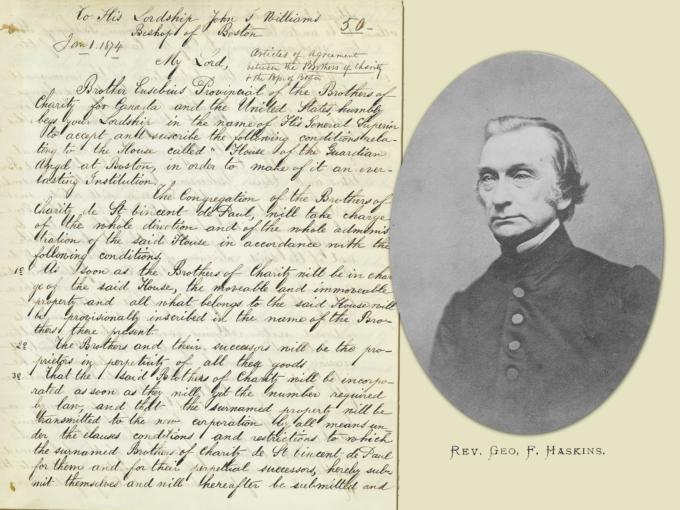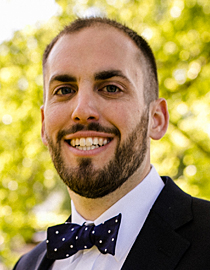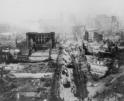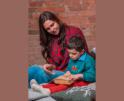
Culture

Lester
On Jan. 1, 1874, Brother Eusebius, provincial of Canada and the United States for the Brothers of Charity of Saint Vincent de Paul, wrote to Bishop John J. Williams of Boston describing the terms under which the brothers would assume control of the House of the Angel Guardian.
The House of the Angel Guardian was founded by Father George Foxcroft Haskins, a Boston native who attended Harvard College and was ordained an Episcopal minister in 1830. He served as chaplain of the Boston House of Correction and, during this time, became acquainted with Catholic priests, including Bishop Fenwick, leading to his conversion to Catholicism on Nov. 21, 1840. After three years studying abroad, he returned to Boston ordained as a Catholic priest, ready to serve the diocese.
Father Haskins was assigned to St. John Church in Boston's North End neighborhood where he was dismayed by the number of homeless boys and, drawing upon his experience at the House of Correction, founded the House of the Angel Guardian. Its mission was to provide a home for boys who had none, and in doing so alleviate pressure on civic institutions to care for this population and avoid the conversion of Catholic children, which often accompanied entry into public facilities. The institution filled a void by complementing St. Vincent Orphan Asylum that provided a similar service for girls.
In reality, many boys on the street did not wish to subject themselves to the discipline required of residents at the institution. Rather, many charges came from families who thought their children could benefit from this lifestyle and paid for their room and board. Other residents worked, and the home provided affordable accommodations until they had sufficient savings to move out on their own.
When it opened on June 1, 1851, the House of the Angel Guardian consisted of a house owned by St. John Church on Moon Street; two tenants, a husband and wife, acted as caretakers. The following year Father Haskins moved to a location on North Square where he purchased three homes, one to serve as the institution itself, and the other two he rented for income to support it. It moved a third time in 1860, leaving the North End for a site on Vernon Street in Boston's Roxbury neighborhood.
Father Haskins devoted himself fully to the institution until his death on Oct. 5, 1872. Anticipating the void in leadership this would create, he had twice traveled to Europe in search of a religious order to staff the institution, so it would continue past his lifetime, but had failed to do so. Upon Father Haskins's death, Bishop Williams and the Trustees of the House of the Angel Guardian took up this cause, and by the end of the year came to an agreement with the Brothers of Charity.
Negotiations appear to have continued as evidenced by the letter from their provincial superior to Bishop Williams, which reveals the final terms under which the order would assume control of the House of the Angel Guardian. Terms included the transfer of all moveable and unmovable property to the Brothers of Charity. There were several conditions that relate to canon law, necessitating the permission of the Bishop of Boston to move the institution, construct new buildings, or secure a mortgage. The responsibility of visiting and inspecting the institution, assigning or removing brothers staffing the institution, and making rules by which the brothers there lived all came under the responsibility of their provincial superior.
There were also several stipulations to help ensure the institution's longevity, including the right of the Bishop of Boston to appoint another order to operate the House of the Angel Guardian should the Brothers of Charity fail in their duty. This would precipitate the transfer of property to that order or, if he should fail to find one, to the Bishop of Boston. It also notes that if the mother house of the order in Belgium ceases to function in that role, the provincial house in Montreal will assume oversight of the operations and staff of the house.
The first six brothers would arrive shortly after this letter was written, on Jan. 27, 1874, and assume control of the House of the Angel Guardian for nearly 100 years. The order would continue to pursue the primary mission Father Haskins envisioned, providing a home for boys while giving them the skills to lead independent lives, but how they accomplished this would be different. Father Haskins believed that a Catholic education and reception of the sacraments were the only things boys required, but the brothers focused on practical skills that would allow the boys to find employment.
Within a decade of their arrival, the Brothers of Charity paid all debts owed by the institution and began construction on a new three-story brick schoolhouse, which would open in 1887, signaling this change in direction. They also began an industrial school on Ruggles Street that opened in 1902, which taught baking, tailoring, shoemaking, printing, and bookbinding, among other trades.
With the need to expand, they transferred to a property in Watertown, the former site of the Perkins Institution for the Blind, and by about 1920 there were 25 teaching brothers and over 300 boys living there. In 1928 they expanded further, opening a site in West Newbury where elementary school children received instruction. In 1947, they would move all operations to this site, renaming it Boyhaven, before closing the institution in 1965.
- Thomas Lester is the archivist of the Archdiocese of Boston.
Recent articles in the Culture & Events section
-
Boston and the nation respond to the San Francisco Earthquake of 1906Thomas Lester
-
See you in the storyLaura Kelly Fanucci
-
'Dignitas' and the mediaRussell Shaw
-
Scripture Reflection for April 14, 2024, Third Sunday of EasterDeacon Greg Kandra
-
St. Helena's House is established in the South EndThomas Lester





